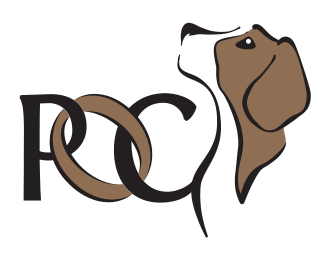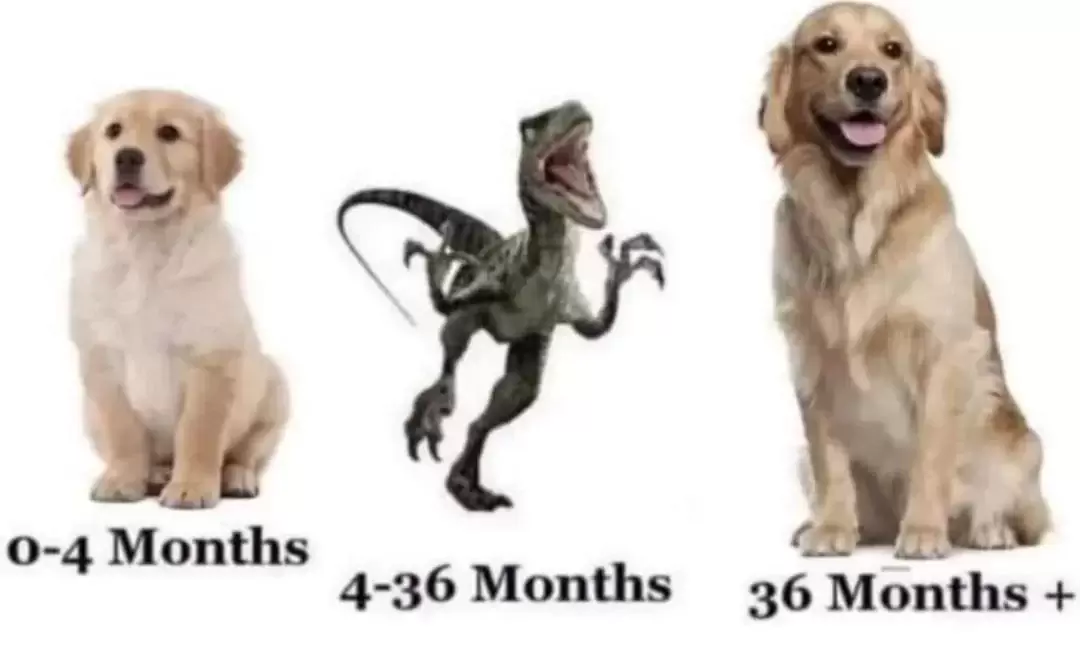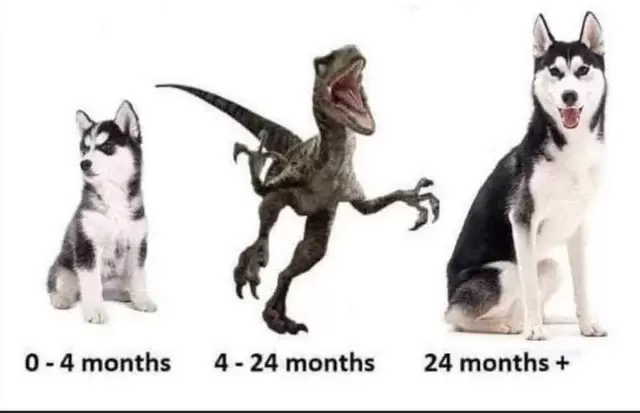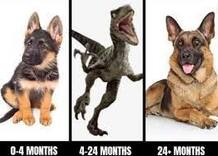|
When considering getting a puppy, people often think about housetraining, chewing, and puppy biting. But what is much less commonly talked about is the adolescent stage of development, when your teenage dog stops coming when called, starts running off or barking at things they never cared about before. You may have seen these memes, they exist in a variety of dog breeds. And they exist, because there is a relatable truth inherent in them, even if somewhat exaggerated. Adolescent dogs often
Why? Because adolescence is the time that they are experiencing sexual maturity, but haven't yet reached social maturity. Their brains aren't fully mature yet, and are undergoing a tremendous amount of neuronal growth and pruning as they experiment with new behaviours and investigate their world. When does my dog become or stop being an adolescent?
It depends! Every dog is an individual. If we define adolescent as a dog from puberty or sexual maturity up to adulthood, we can make some generalizations. For example, the standard smaller dogs start and end earlier, as they tend to mature faster than large and giant breed dogs. And, not all dogs have a challenging adolescent phase. Some puppies are pretty easy going and continue that into adulthood without much of an issue. But, adolescence is the most common time for people to find their dogs challenging. One study found that dogs returned to the shelter had an average age of 16.28 months. And I remember having a student comment to me years ago when working with her adolescent dog "now I know why so many dogs on Kijiji are 9-18 months old!". So What Can We Do? Good news! You don't need to just cross your fingers and hope. There are things you can do to both help your puppy have a smooth adolescence, and to help your adolescent make it to adulthood in your home. Puppies - Don't stop rewarding what you like! Especially coming when called. Take advantage of this time, and a young puppy's natural desire to remain close to you and return to you to build up a strong reinforcement history, so that when increased environmental interest and independence kick in, you have a greater likelihood of having an adolescent that is still somewhat interested in you. Practice Neutrality One of the biggest adolescent challenges I see is the over-excited adolescent. They are so excited by seeing a person, a dog, or going to a new space that they can't think. If you imagine a kid at Disneyland, that's what they look like. The problem is, their people didn't take them to doggie Disneyland, they just went for a walk. If you want your dog able to walk calmly past people and other dogs, they need to practice that. Ideally, starting as a puppy. But if they haven't, that's okay, you can start by finding places where the activity will be at a distance, and gradually work closer. Calmly glance at dog? Treat for you. Walked past a person without pulling/jumping, treat for you. That way, you have the good stuff, and seeing a dog or person doesn't automatically predict an exciting interaction. When dogs form an association between seeing a dog or a person and having an exciting interaction, that anticipation creates excitement the moment the person/dog is spotted, and leads to pulling, jumping, barking, etc. Foster Stable Social Relationships with other dogs Quality is way better than quantity! Especially when it comes to other dogs. With young puppies, we are trying to preserve their optimism and avoid a scary experience. With adolescence, we're often trying to prevent them from being a bit too much with their increased energy and big feelings. On top of that, their "puppy license" is often being revoked. Just like us humans know that toddlers and young children don't know all of the social "rules" yet, and give them some extra grace when they do or say things most adults wouldn't, adult dogs give young puppies grace that they don't always behave the way they should. However, as a puppy starts maturing into an adult, many adult dogs think that the adolescent should show more appropriate social behaviours and are less tolerant of an adolescent's faux pas. Some adolescent dogs undergoing sexual maturity also become a bit cocky, or overly confident in their abilities and coupled with impulsiveness, this can get them into trouble. Not unlike human adolescents, the rational prefrontal cortex area of their brain isn't fully developed yet, so they can find themselves in situations they didn't plan to be in, or facing consequences they didn't consider. If you see your adolescent exhibiting behaviour that is a bit too much or over the top toward another dog, step in, interrupt and redirect them so the other dog doesn't feel the need to escalate the situation or develop resentment towards your dog. Enjoy the Fun Your adolescent has a lot of energy, spend some time exploring what they like to do, and how they like to play. This builds your bond, as you continue to be a source of fun things instead of the one always saying no, and allows you to develop a variety of activities your dog enjoys. Give them some appropriate outlets for their energy - walking, swimming, running (if you have access to a safe space), chase games (they chase a toy, you chase them), fetching games, etc. Our adolescents need opportunities to move their body. Engage the Brain Although our adolescent dogs are at their peak in terms of physical energy, physical exercise alone isn't the best way to a content dog, especially if you have a dog whose ancestors have been selected for their ability to run all day. Unless you can spend all day every day working your dog, you won't tire them out with physical exercise alone. Instead of depending solely on the old "a tired dog is a good dog" diversify. Give your adolescent opportunities to use their brain.
Rehearse Calm Just like us, dog's don't generally respond well to "calm down". But, calmness in different situations is a skill that we can grow in our dogs. First, consider if there are some times you want your dog to settle and not pester you. Then set them up for success by first giving them some physical and mental exercise, and possibly a quiet occupier like a chew when you begin your activity. While you're busy, you're unavailable for petting or toy tossing, but you can acknowledge requests and remind them to settle on their place or play with a toy. You can extend this to going on car rides to no where. Sitting and watching the world go by. Different situations in which you want your dog to know that it isn't about them right now. Calmness can also be the key that unlocks fun things. Since what gets practiced gets repeated, and dogs in excited states don't make good choices, it is wise to have access to exciting things rely on the ability to settle. However, you need to also keep your criteria realistic, and be patient to avoid frustrating your dog. For example, to avoid dogs jumping on the door, sitting could be required to get access to the fenced yard. But in the beginning, a young dog may not be able to sit very long or very still in this situation, but if you start with accepting a sit, even if it is wiggly at first, then as your dog starts to understand better, increase your criteria to a short moment of stillness while sitting, you can shape your way to a calm sit to go play outside. Other things that could be unlocked by calmness include greeting people, play with another dog, car ride, ball toss, etc. Work on that Come Back to that classic adolescent problem.
And most of all, enjoy the ride. Along with the moments that make you want to pull your hair out, will be ones giving you a glimpse of the amazing adult they will become. And if your puppy sails through adolescence without a hitch, know that the rest of us are all envious. Comments are closed.
|
Categories
All
Archives
May 2024
|
Online Learning Class Schedule Puppy Classes Manners Classes Sport Classes Scent Classes Agility Classes Private Lessons
Copyright 2020 Positively Obedient Canines



